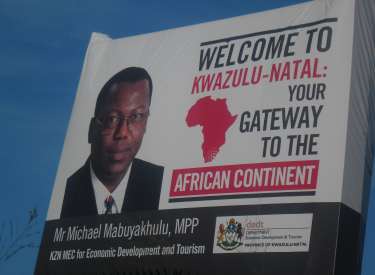While five heads of states of Brazil, Russia, India, China and South Africa (BRICS) met in Durban last week for the developing nations’ summit, civil society organizations gathered as “brics-from-below” under the banner of “Watching and challenging power”. Through a week of intensive sessions, mass meetings, and protests, they shared experiences and networked around issues. This countered BRICS governments’ common use of radical rhetoric around anti-imperialism and Northern multi-nationals while they promote investments by their countries in infrastructure, mining, energy, and agriculture.
According to the brics-from-below press statement: “The prospect that South Africa ‘presents a gateway for investment on the continent’ could leave Africa overwhelmed by BRICS corporations and is indicative that the trajectory of the 21st-century ‘scramble for Africa’ has already begun. Africa’s ‘resource curse’ will attract billions of dollars’ worth of BRICS infrastructure developments. In this light, the BRICS summit in Durban is set to be the next successor to the initial carving up of Africa, which took place in 1885 in Berlin.”
What does “investment” mean for water in Africa? On 26 March, Blue Planet Project Organizer Mary Galvin spoke to over 70 activists at a brics-from-below session on land, agriculture and water. She highlighted how promised “investment” from the private sector never materialized in the area of water services, and how the private sector’s engagement with water resources may be more sinister. Examples include private ownership of technologies needed to access water in areas facing water scarcity, water grabs, and the assertion of corporate influence/ control through the Water Resources Group (see earlier blog on private ownership of water resources).
She highlighted the “pain and gain of ‘investment'”:
1. Government welcomes the corporations and develops a close relationship that it considers win-win.
VERSUS
Government’s neediness leads to dependency and poor regulation (or even a situation of a ‘captive regulator’)
2. Government sees ‘investment’ as increasing GDP and creating jobs and is willing to re-allocate resources to support investors’ work. Infrastructure development as a spinoff of investment.
VERSUS
Profit is repatriated, few jobs are created, and non-renewables are used. Water is allocated to industry, mining, and agriculture over people’s livelihoods and development.

This is evident in massive dam building like the Lesotho Highlands Water Project to provide water to industry around Johannesburg or like Belo Monte dam in Brazil, which will be the third largest dam in the world. Blue Planet Project’s recently released report Dam Truths: A Compilation of Case Studies about Popular Struggles Against Big Dams shows how such dams result in displaced people, abuse of indigenous rights and possibly violence, no or inadequate compensation, people lacking access to water or electricity from a neighbouring dam, ecological damage, and potential danger downstream.
She concluded with Maude Barlow’s warning:
“We have a huge fight on our hands over our water and our resources, and I think in the next few years we are going to see a lot more people stand up physically with their bodies in front of bulldozers and heavy equipment and mining companies and so on just to try to stop the damage.”
“Investment” typically fulfills corporate interests of power and profit. Civil society needs to hold government accountable from inside and outside, and to promote a paradigm shift from a neo-liberal focus on fixes such as large dams to one of community control of the commons.



